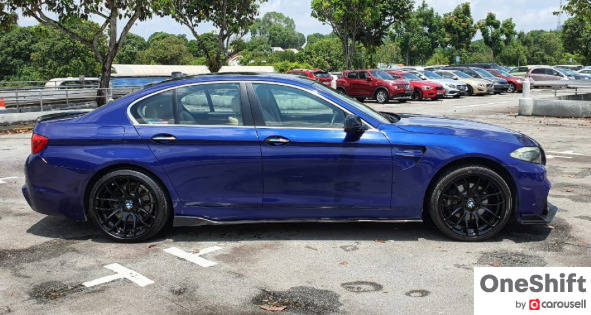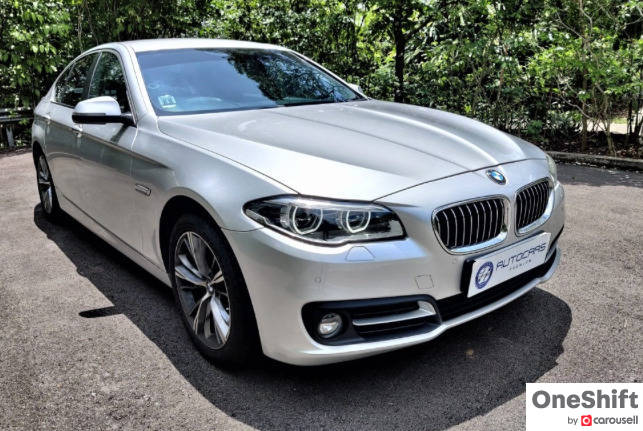OneShift Buyers' Guide For The BMW 5 Series (F10)
You’d be forgiven if you reasoned that BMW first established its brand with its 3, 5 and 7 Series lineage, given their tremendous influence over the decades. Oddly enough (pun intended!), its identity was also shaped in the 60s with the “New Class” (or Neue Klasse in German speak) range, starting with the 1500 - a top-selling 4-door compact sporty sedan that almost single handedly saved the company from bankruptcy. Larger models of the Neue Klasse heritage were introduced in the late 60s. Why was this significant? This paved the way for the introduction of the first-generation 5 Series at the 1972 Frankfurt Motor Show, codenamed E12.







You’d be forgiven if you reasoned that BMW first established its brand with its 3, 5 and 7 Series lineage, given their tremendous influence over the decades. Oddly enough (pun intended!), its identity was also shaped in the 60s with the “New Class” (or Neue Klasse in German speak) range, starting with the 1500 - a top-selling 4-door compact sporty sedan that almost single handedly saved the company from bankruptcy. Larger models of the Neue Klasse heritage were introduced in the late 60s. Why was this significant? This paved the way for the introduction of the first-generation 5 Series at the 1972 Frankfurt Motor Show, codenamed E12.

The E12 pioneered BMW’s three-digit naming convention (Eg: 520, 525 etc..), and was one of the most successful model series ever as far as sales were concerned, with more than 700,000 sold worldwide during a production run that spanned nine years. The second-gen 5 Series (E28) followed, headlined by BMW’s decision to offer a turbo diesel variant that could reach a record-breaking top speed of 180km/h. The third-gen 5 Series, built from 1988 onwards, might look more conservative than its predecessors as it was developed alongside the E32 7 Series. But it was daring in its approach as it offered, for the first time, a “Touring” variant - a wagon bodystyle that appears highly relevant and desirable till today.
The mid 90s saw the introduction of the fourth-gen E39 5 Series - a standout feature being dual headlights surrounded by light rings (more commonly referred to as “angel eyes”). It was also the first mass-produced production car made almost entirely of light alloy. And not forgetting that the M5 variant was the first M5 to be powered by a V8 motor. The fifth-gen (E60) was equally eye-catching, for the right (or wrong reasons). Love it or hate it, its design led by Chris Bangle polarised opinions. When paired with a new in-car entertainment system called “iDrive” that was still in its infancy back in mid 2000s, we reckon that it still performed way beyond our expectations with 1.4 million units sold until 2010.
We will take a deeper dive into the sixth-gen (F10) later, but when looked in its entirety, the sixth and seventh-gen (G30) 5 Series in our opinion do not look too different - the G30 might even get away with being labelled a Life Cycle Impulse (LCI) / facelift version of its predecessor. The current M5 was a turning point for car enthusiasts, for better or for worse. It came with a party trick for the range-topping BMW M5 - an all wheel drive system - a first for an M5.

The post-Bangle design era made way for a less flamboyant styling, but key improvements beneath its skin were made to make it a more accomplished companion. The sixth-gen F10 sedan featured a front double wishbone suspension - an upgrade from the fifth-gen’s Macpherson strut setup. It is based off the F01 7 Series, too. Electric power steering was also introduced, along with an active rear wheel steering that aids tight-corner manoeuvres - a welcoming addition given how much the 5 Series has grown over the decades. It was also the first 5 Series to offer a hybrid powertrain. This gen also introduced a new “fastback” design (Gran Turismo) - a controversial form factor that we feel placed functionality way above aesthetics and desirability.

We dug our archives and realised that more than 500 orders of the F10 were placed even before its launch at the end of May 2010. That sent a strong statement of intent (and a slap in the face) to its E Class rival that was already launched at the tail end of 2009. It arrived in two variants first - a 204bhp 2.5-litre 523i, and a higher-specced 3-litre 535i - both equipped with an inline six cylinder that also powered the 335i, albeit in different states of tune. There was slight confusion back then with regards to the way it was turbocharged, because the 5 Series was fitted with a “TwinPower Turbo” that utilised one single turbocharger with twin scroll technology. Earlier variants of the six cylinder turbocharged 335i had a six cylinder powered by two physical turbos instead.
A more “realistic”, tax friendly version was introduced in the form of the 2-litre, four cylinder 5 Series (520i), which replaced the 523i in 2012. A 2.0-litre, four cylinder 528i was also introduced in the same year, signalling the continued trend of downsized engines with capacities that did not represent their nomenclatures. We also saw a couple of 520d on local roads in the early-mid 2010s. It was a left field choice back then as the rev-happy nature of its petrol siblings made way for a torque-rich diesel motor, which in hindsight made plenty of sense for city driving. A couple of decade-old F10 ActiveHybrid 5s are also in the market, which claim an electric-only range of 4km. On top of the F10’s hierarchy sits a M5 that substituted the E60’s howling V10 screamer with a more sophisticated, but no less potent 4.4-litre turbocharged V8.
Mileage for the F10 varies quite drastically, but we reckon that regular owners will drive it quite frequently, so an estimate of 80,000km - 100,000km for a six year old example, and 170,000km - 190,000km for a unit that has its COE renewed are realistic figures.

If you’re sourcing for a pre-November 2011 unit, keep an eye on any recalls that were directed to faulty engine bolts. If left unattended, oil leaks could occur and the “Check Engine Light” signal could light up. If you’re looking for any diesel models manufactured before 2014, do watch out for faulty camshaft tensioner and chains that generate a consistent ringing noise.
For petrol models, the high-pressure fuel pump can be known to be faulty - do be careful as that could cause a sudden loss of power and resulting engine failure. For a F10 M5, do check for records on a defective oil pump if it is registered between July - September 2012).
For F10s that are more than 10 years old, do pay attention to its aging suspension joints and brakes - they’ll likely need to be replaced every 30,000km - 40,000km. They are relatively heavy too (weighing in at least 1,650kg for the base-spec), so tyres will require more thorough checks, alongside brake pads and discs.

Do check if the F10 you’re eyeing is produced between September to October 2016, as they could fall under a recall, which fixes a potential issue with airbags that deploy incorrectly in an accident. As with most BMWs, replacement parts do not come cheap. Scrutinise for stone chips on the headlamps, foglamps, windscreen and even side mirror caps - there should be only minor scars, if not it could lead up to larger cracks and water seepage, setting you back at least a couple of hundreds to rectify if you’re lucky.
As the F10’s condenser is exposed, it could be subjected to high-speed stone chips. Welds in the air conditioning / climate control condenser on a couple of F10 models might fail, and that will deplete coolant levels. No harm turning on the air conditioning during your test drive to ensure the unit functions well. Before you set off, do examine the front footwells - stay clear of the unit if it feels damp, as water might have seeped through from the front bulkhead. While inspecting the cabin, toggle with the dashboard buttons to ensure that they are all in working order - they should be functioning perfectly even though their “rubber-like” materials on touch points are known for quick wear and tear.

We’d thought that the long wheelbase (Li) treatment might only be reserved for the 7 Series lux-limo, but customers in China could also opt for the Shenyang-built (Li) variant (codenamed F18) of the 5 Series, with longer rear doors than the F10. This makes plenty of sense, given that the F10 5 Series shares the same platform as the F01 7 Series.

If you’re lucky, you could snag a 523i for slightly less than S$10,000 depreciation a year, with most examples in the marketplace having COEs extended till 2030. Depending on how you look at it, it could be a “steal” as it comes fitted with an inline six motor - a rarity nowadays. But of course that will have an impact on your road tax (S$2.2k per year compared to the 2.0-litre 520i’s S$1.2k per year). If you have S$12,000 to S$14,000 per year to spare, you can shortlist the 535i or a slightly newer 528i. Newest units of the F10 will be registered around 2016 - most of them in 520i spec, with depreciation ranging from S$16,000 - S$17,000 per year. For a car with multiple engine variants, after factoring their estimated age and mileage, it’ll be safe to predict a fuel consumption of 10-11km/l on the combined cycle. Assuming that we cover 1,000km per month, it will set you back around S$300 monthly based on current RON95 prices.
A low mileage, 2-owner unit 528i with a M Sport package. COE expires in June 2023.

This example has depreciation set at around S$10k per year, with 8 years left on a renewed COE cycle.

A unit registered in June 2014 in silver with a black interior. Owned by a “fussy owner” according to the description.
Keen to acquire a F10 BMW 5 Series? Find more pre-loved examples on Carousell.
Airbags could deploy incorrectly in an accident High Bolts (engine) *Some F10s produced between September to October 2016 Oil leaks could occur and the “Check Engine Light” signal could light up High Camshaft (engine) *Some diesel F10s manufactured before 2014 Monitor for consistent ringing noises High High-pressure fuel pump (engine) *Some petrol F10s Could cause a sudden loss of power and resulting engine failure High Oil pump (engine) *Some F10 M5s registered between July - September 2012 Could be defective High Welds in air conditioning / climate control condenser (interior) Stone chips at high speeds could puncture the unit, depleting coolant levels High Suspension joints Monitor for wear and tear Moderate Dashboard buttons (interior) Materials on touch points known for quick wear and tear Low
Credits: Gerald Yuen

- Convenient and Hassle-Free
- Consumer Protection
Transparent Process
With No Obligation


Get the Best Price for your used car
from 500+ dealers in 24 hours













